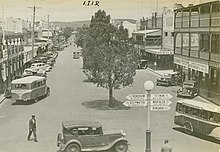
Grafton is a city in the Northern Rivers region of the Australian state of New South Wales. It is located on the Clarence River, on a floodplain, approximately 608 kilometres (378 mi) by road north-northeast of the state capital Sydney.
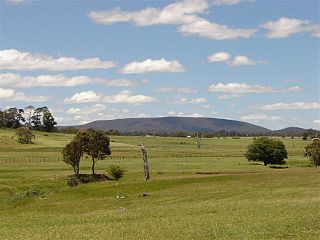
New England is a geographical region in the north of the state of New South Wales, Australia, about 60 km inland from the Tasman Sea. The area includes the Northern Tablelands and the North West Slopes regions. As of 2021, New England had a population of 185,560, with over a quarter of the people living in the area of Tamworth Regional Council.
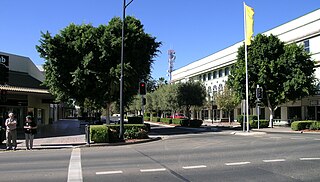
Moree is a town in Moree Plains Shire in northern New South Wales, Australia. It is located on the banks of the Mehi River, in the centre of the rich black-soil plains. The town is located at the junction of the Newell Highway and Gwydir Highway and can be reached by daily train and air services from Sydney.
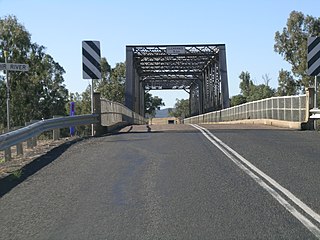
Gwydir Highway is a 568-kilometre (353 mi) state highway in northern New South Wales, Australia. The highway was named after the Gwydir River, which in turn was named after a locale in Wales.

Ballina is a town in the Northern Rivers region of New South Wales, Australia, and the seat of the Ballina Shire local government area. It lies 740 km (460 mi) north of Sydney and 185 km (115 mi) south of Brisbane. Ballina's urban population at the end of 2021 was 46,190. The town lies on the Richmond River and serves as a gateway to Byron Bay.

Bingara is a small town on the Gwydir River in Murchison County in the New England region of New South Wales, Australia. Bingara is currently the administrative centre for the Gwydir Shire that was created in 2003. The Gwydir River being a main highlight of the town is a main catchment of the Murray-Darling System.

Glen Innes is a parish and town on the Northern Tablelands, in the New England region of New South Wales, Australia. It is the centre of the Glen Innes Severn Shire Council. The town is located at the intersection of the New England Highway and the Gwydir Highway. At the 2016 census, Glen Innes had a population of 6,155.

Ashford is a small village situated in the north-west on the Northern Tablelands of the state of New South Wales. The New England rural village of Ashford lies within the broad sunlit lands 748 km north of Sydney, 500 km south west of Brisbane, close to the Queensland border. Ashford is 430 metres above sea level and located 56 km north of Inverell on a major arterial road, connecting the Gwydir and Bruxner highways through to the Queensland border.

Warialda is a town in the North West Slopes region of New South Wales, Australia, in Gwydir Shire. It is situated on the banks of Warialda Creek. At the 2011 census, Warialda had a population of 1,120.

Gwydir Shire is a local government area located in the New England region of New South Wales, Australia. The northern boundary of the Shire is located adjacent to the border between New South Wales and Queensland.

Quirindi is a small town on the North West Slopes region of New South Wales, Australia, in Liverpool Plains Shire. At the 2016 census, Quirindi had a population of 3,444. It is the nearest link to Gunnedah to the northwest and Tamworth to the north. The local economy is based on agriculture, with broadacre farming dominant on the black soil plains to the west and livestock grazing in the hilly eastern part of the district.

Tingha is a small town on the Northern Tablelands, New South Wales, Australia in Inverell Shire. Formerly part of Armidale Region, on 1 July 2019, responsibility for Tingha was transferred from Armidale Regional Council to Inverell Shire Council. The town is 30 kilometres (19 mi) south of Inverell and 559 kilometres (347 mi) north-north-east of Sydney. Tingha is an Aboriginal word for "flat or level".
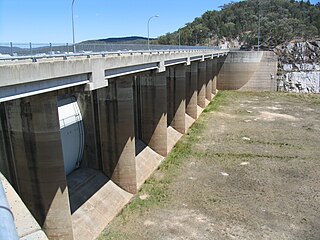
Copeton Dam is a major clay core and rock fill embankment dam with nine radial gates and a gated concrete chute spillway across the Gwydir River upstream of Bingara in the New England region of New South Wales, Australia. The dam's purpose includes environmental flows, hydro-electric power generation, irrigation, and water supply. The impounded reservoir is called Lake Copeton.
The North West Slopes region of New South Wales, Australia, refers generally to the area west of the Northern Tablelands, to the north of the Central West region and to the east of the Far West region. Despite its name, the region is in north-central New South Wales, corresponding generally to the Australian Bureau of Meteorology's forecast area of North West Slopes and Plains. The administrative areas of the region include the city of Tamworth, Gunnedah, Moree, Narrabri and Inverell.

Inverell Shire is a local government area in the North West Slopes region of New South Wales, Australia adjacent to the Macintyre River and the Gwydir Highway.

Dorrigo, a small town on the Waterfall Way, is located on the Northern Tablelands, in northern New South Wales, Australia. The town is part of Bellingen local government area.

The Inverell railway line is a closed railway line in New South Wales, Australia. The line branches from the Mungindi line at Moree and travels in an easterly direction through the town of Gravesend then Warialda Rail, gradually increasing in elevation through Delungra towards the terminus at Inverell. An initial estimate of its intended length was 96 miles 35 chains (155.2 km). The line opened in February 1900 as far as Gravesend, then more of the line in 1901 before the Gwydir River bridge was finally finished and the line completed in 1902. It was progressively closed between 1987 and 1994. Currently a 5 km (3.1 mi) section at the Moree end remains in use as a siding for the storage of railway wagons. On 8 August 2016, The NSW Government announced that a 2.8km section of the railway would be reinstated to allow grain to be sent by rail, as part of the Fixing Country Rail pilot round. Up to $2 million was allocated for the project.
Biniguy is a village in Moree Plains Shire of New South Wales in Australia. At the 2016 census, the village and surrounding area had a population of 147. The village is located on the Gwydir Highway approximately 40 km (25 mi) from Moree, the main service centre for the region and 645 km (401 mi) by road from the state capital Sydney. The village is prone to seasonal flooding; in February 2012 the entire village was evacuated by helicopter to Moree
Myall Creek is a locality split between the local government areas of Inverell Shire and the Gwydir Shire in New South Wales, Australia. In the 2016 census, Myall Creek had a population of 38 people.
Copeton is a small rural locality in the Gwydir Shire and Inverell Shire of New South Wales, Australia.


